The Dawn of the Antibiotic Era: The Penicillin Story and The Fleming Myth
The true account of the Penicillin Story (Correcting the errors)
It's not September 28 (an important date to the antibiotic era of the medical world) yet but in the midst of the antibiotic resistance campaigns and situations; let's takes a look at how the antibiotic era started as history has a way of giving us solutions to our problems (the conclusion of this post surely justify this statement, you could scroll to the conclusion, but you won't get a proper understanding of the post which is why you are here)
The penicillin story could look as simple and familiar as portrayed on the internet, novels, kids story books and in some cases as a famous quest story (stories aimed at enabling us to remember a large volume of information revolving about a hero who through divine or miraculous intervention solved a problem-so common). However, it is one scientific-story loaded with myths and complexities as it revolves around money and public recognition (will agree with me these two sure come with a lot of problems if not taken care of).
The discovery of penicillin is usually considered a miracle, funny, lucky event or the popularly EUREKA MOMENTS; it is an example of findings in the science world which arises from accidents with the discovery of saccharin (a sweetener) being another (uh huh, guess you don't know). Even Fleming said this about his discovery.
"I did not invent penicillin. Nature did that. I only discovered it by accident."
Fleming should be a superhero with the title "accident man" as his first discovery (lysozyme) was also a product of chance/accidents.
Before the discovery of penicillin, people died from less virulent diseases and infections due to the lack of a solution from the doctors. Then, a simple cut leads to a high number of deaths due to infections caused by microbes feasting the injuries (a simple cut as simple as ABC). Also, women died during and after childbearing and in some cases the infants also becoming deceased. Terrible, you say, people wondered if they will be alive to see the next day.
Not all
The situation got worse during the World Wars as many soldiers died more from the muddy wound inflicted on them during the battle which was now infected with microbes as they lack proper treatment. In some cases, the injuries resulted in gas gangrene, a deadly bacteria (mainly the Clostridium species- group of bacteria transported mostly by soil) infection.
It involves the death of the muscle tissues due to the presence of gases (hence the name of the disease) made by exotoxins produced by bacteria, and you could hear the doctors whispering to their nurses/assistants, we will need to cut this limb (was the only solution).
The use of antiseptics like carbolic acid/phenol encouraged by Joseph Lister (a Scottish doctor) was the only available method of treating those wounds which explains why other surgeons were not giving in to the disapproving report of Fleming and team on the effectiveness of antiseptics on the injury during the war outbreak in 1914.
Fleming and his team noticed the antiseptics were not effective in treating the microbes infested wounds to the core, not only that, did more harm than the overspreading bacteria by killing the blood soldiers (phagocytes- defend the body against infections), soon the surgeons gave in to the team findings.
Even the sulphonamides, a group of anti-microbial drugs made from dyes used to stained microbes such as prontosil which was discovered after penicillin could not solve all of the bacterial infections. Attacking only some bacteria's (primarily streptococci), issues of resistance with bacteria's they attacked, drug side effects and allergies were the major problems affecting their effectiveness.
In all of this it will be unfair to our competent immune system (You would want to offend them, so be nice) to say that people in ages before the introduction of antibiotics easily give in to these deadly infections like tuberculosis as they were people (survivors) who outlived those fatal infections repeatedly, however we will be unbiased to say the mortality rate has reduced.
LUCKY DAY
Alexander Fleming (third time the name is coming up-Who is that?), a Scottish scientist (more than that), was investigating changes in specific properties of S. aureus (a Gram-positive bacterium, group of bacteria that test positive using the gram staining method under room temperature) based on this research on S. aureus colonies.
Leaving for vacation, he piled his S. aureus harbouring culture plates/Petri dishes (a habit which he was fond of irrespective of periods of leaves) at one side of his bench close to the window to give space for his new colleague to work with while he will be away.
Fleming also had a custom of carefully examining his culture growths before disposing them into disinfectants which explains why he like heaping up his cultures and September 28, 1928, was not an exemption (he was a curious being). Picking the top culture plate, he noticed a funny condition, inside the culture was a fungal contaminant/mould forming a zone of growth which was approximately 20mm in width and had a yellowish-green colour.
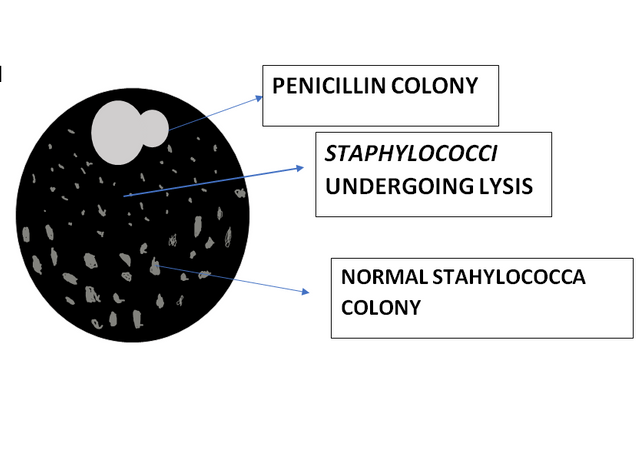.png)
On close analysis, Fleming noticed a crystal clear region around the mould zone due to the destruction of the Staphylococcal colonies (lysis in biology) whereas far away from the zone, were the existing normal S. aureus colonies. You could see the funny expression (the Eureka moment) on his face on noticing this scenario. He tried to share this moment with his former assistant, Dr. Merlin Pryce, who walked in, only to give no attention and reminded him of the funny moment surrounding his previous discovery- Oh that's how you invented lysozyme (Oh poor man he missed the opportunity of being a great discoverer).
The fungus contaminant was proved by Fleming former assistant, Hare, to be from a heap of moulds in laboratory precisely underneath that of Fleming's which was gathered by a mycologist, C J La Touche. Touche was investigating the desensitizing effect (making less sensitive) of the extracts from the mould on the asthmatic patients of John Freeman, the allergist (someone who specializes in the field of asthma and allergy). Touche laboratory was not a standard one as it lacks a fume cupboard to work in, he could only make use of tables in the lab.
Birds of a feather flock together.
The two (Fleming and Touche) never close the door to their labs.
Hare further proved that the spore from the mould fungus might have found its way to Fleming's lab through the open lift shaft and stairs around it and by chance dropped on the culture plate while Fleming was preparing and spreading his S. aureus culture. Thus disapproving the familiar and rumor story of the spores coming through the window.
Fleming was not the first scientist to notice the bacteriostatic action of moulds; a handful of scientist also saw it and was a standard way of treating infected wounds in Europe way backs the middle ages. But he was the first to follow up and investigate more on the bacteriostatic property of the mould. He transferred some cells from the mould culture to a new growth media which was a nutrient broth (a process known as sub-culturing) to maintain the cell line and increase the number of cells for further experiment.
He observed at first that the mould build up into a massive silky mat-like structure which later produced a sharp yellow colour-clear fluid after some days, a phenomenon which was later found to be associated with the fluid expanding antibacterial action. After eight days, the fluid at room temperature completely inhibited the growth of staphylococci at a dilution rate of 1 in 500. At first, the fluid produced by the mould was named mould juice but later renamed as penicillin, a name we are all familiar with in this present era.
Many have argued that Fleming did not engage any scientific method on discovering penicillin, which we can see is entirely untrue as he participated in further experiments and also went ahead to collect data which he presented in tables and graphs. He also gave a credible explanation for the data that the fluid (penicillin) inhibited the bacteria growth, all this he did publish in the British Journal of Experimental Pathology, a write-up which did not see the light of any scientific attention for decades.
A problem
Discovering and culturing the penicillium mould was more comfortable, but extracting the principal antibacterial agent (penicillin) was difficult. Before penicillin could be used on humans, it has to be purified and produced in large quantities which were the major problems of Fleming then. Unlike other antiseptics that kill microbes within a couple of minutes, penicillin took a lot of hours to start functioning thus seeming to be slow. Another problem Fleming noticed was penicillin losing its power before having any effect on the microbes in a compound containing blood serum, with this, proving it will not last in the human body and thus making it look like penicillin was ineffective. All this was due to the little knowledge of chemistry by Fleming and his assistant, Stuart Craddock.
Luckily (this word again) there was an ophthalmologist (eye-related), Frederick Ridley, who had taken a biochemistry course for BSc students at Birmingham University with Fleming then and was working on the effect of lysozyme on eye infections. He was therefore assigned to extract and purify the penicillin from the broth alongside Craddock (Fleming assistant). Apart from any of them having a substantial chemical background, the available method of extraction was crude compared to the present day refined and modern chemical method of extraction. The crude way involved filtration, evaporation, and distillation. Ridley and Craddock cultured the mold inside bottles lying on their flat side (longer side) containing the liquid medium (broth) with cotton wool and tin foil serving as the cork to the bottle.
As Fleming noticed, the mold produces the felted structure on top of the liquid medium and the yellow fluid at the base. The liquid was filtered off impurities through a chain of materials, from cheesecloth to paper and finally by asbestos pad inside a Seitz filter aided by a bicycle pump to supply compressed air. The filtrate produced was the clear yellow fluid alongside water which needed to be removed to maintain the concentration of the fluid (first step). Using the standard cooking method of drying up watery-mixtures by boiling will destroy the mould filtrate activity due to the intense heat, so they employed the vacuum distillation method- distillation at lower pressure.
The absence of standard equipment's made them use inefficient pumps and carry out distillation at 400C and pH less than 6.5, a process which took all day. The product of this hectic process was discouraging as it contains almost all the unwanted original materials in the broth except water. Confused if penicillin was an enzyme and likewise a protein (enzymes are proteins), they added 70ml of 90% alcohol to the solution because proteins are insoluble in alcohol.
This mixture formed a large precipitate and a fluid mainly made of alcohol and water; they tested the two fractions for penicillin activity. The fluid was discovered to have the most excellent penicillin activity with a titre value (simply a measurement of conc.) of 1 in 3000 (10 X higher than the initial) now proving that penicillin is not a protein due to it dissolving in alcohol. Although the addition of alcohol was for the protein test, it opened a better way for concentrating and purifying penicillin partially because evaporation at low temperatures favoured solutions with alcohol as the solvent.
Since the alcohol was of no use, it was eliminated through vacuum evaporation to yield 0.5ml syrupy remains which were later dissolved in 5ml of water to give a solution with titre value ranging from 1 in 3000 to 1 in 5000. These solutions were only stable for few days (their antibacterial activity seems to be invisible after few days), and could only last for 7-10 days when stored in ice in liquid form. They tried other solvents like ether and chloroform but seem to be ineffective at purifying penicillin, although acetone tried to look like it as it produced a precipitate with little penicillin activity and also contained chrysogenin, a non-antibiosis compound which gives the fluid its yellow colour; yet still unstable.
The year 1934 was to be the penicillin year. Unfortunately, it was not. Joining Fleming's department at St Mary Hospital (Inoculation Department) this year was Lewis Holt, who appeared to be the bringer of hope (Not the bringer of rain-Spartacus) in the penicillin purification movie considering he was a chemist. Unaware of Ridley and Craddock earlier experiment (not even the smallest detail), he tried extracting penicillin from the mold adopting amyl acetate as the solvent being aware penicillin dissolves in organic solvents like the chemist he was. He was close to purifying penicillin, but his addition of sodium bicarbonate to the fluid caused the setback, as penicillin activity was sensitive to alkalinity (pH of NaHCO3 used=8).
Like you know, the Oxford team (Howard Florey and Ernst Chain) finally purified penicillin employing ether as the solvent and the method of freeze-drying (improved vacuum distillation method in which water vapour is removed from solid ice through a high vacuum combined with a low-temperature condenser like the case of some dried ice cream) to obtain brown powder penicillin.
Having purified the mold, the next stage was to test the effectiveness using an experimental animal like a mouse before use by humans, a style of research similar to that employed in studies of this present age. Their experimental animals were made up of 8 mice injected with a deadly strain of Streptococcus of which a set of 4 received an injection of single doses of penicillin, and the other set of 4 were kept in their cage as the control group. Like every good scientist, returning the following morning to observe their experiment, they said Oh yes, we did it as the control group was dead but the other set given penicillin doses were much alive.
But not all, there exists little information on how long, required dosages, how often should penicillin be given, so they carried out series of tests and finally published their result in The Lancet (a medical magazine) in August 1940.
We were next. Humans will require a dose of penicillin almost three thousand times that of a mouse which will involve making close to 500 litres of mould juice per week for months, a task which seems impossible as no pharmaceutical companies were willing to help. They resulted in using the Duncan school as the factory with the Penicillin girls as the factory workers.
By February 1941, the team appeared to have produced enough dose of penicillin to treat a human. The first human to receive penicillin was a policeman who suffered from infections from a rose bush scratch (yeah as little as a scratch)) which already led to several abscesses on his body, a remarkable improvement was recorded after 24 hours of receiving penicillin injection but later died (seems little scratch was not just little then) as there was no more penicillin to treat him.
Successful experiments on 170 patients were subsequently recorded between 1941 and 1942 showing the significant effect of penicillin on bacterial infection with no toxic effects.
War and Production
Penicillin was not the only thing that was unstable between 1928 and 1939, the world was also unstable due to the world wars, and hence this story will be incomplete without discussing the effect and relevance of the fights on purification, production, and distribution of penicillin.
The Oxford team saw the importance of penicillin to the health of wounded soldiers during the wartime but was faced with the challenge of mass production in Britain due to the country commitments during WW2.
They resulted in seeking for help from the U.S. government in June 1941 which was not at war then. They stained their coat to ensure the safety of the mould while travelling to Illinois.
Alongside their American Colleagues which include Charles Thom, a mycologist at the US Department of Agriculture and director of the department's Northern Research Laboratory they created the Penicillin project which had three branches.
A branch focused on improving purification method which led to the discovery and adoption of the deep-tank fermentation method and a subsidiary focused on finding and characterizing more strains of Penicillium. The last department concentrated on finding pharmaceutical companies for the massive production of penicillin, which yields 15 drug companies from U.K and U.S.
The first series of trials during the wartime took place in North Africa military hospitals in 1942(all thanks to the penicillin project). The British tried every possible means to prevent the information on the method of production of penicillin from reaching the enemies. The leading country on the Britain list was Germany who later got it but was unable to grow it. Other European countries also got the penicillium mould, France got a fake strain of the mould incapable of producing penicillin, but later they produce a little quantity only capable of treating approx. 30 patients.
Netherlands was one of the countries to provide a significant amount of penicillin (secretly) in a company named the Nederladsche Gist-en Spiritus fabriek (The Netherlands Yeast and Spirit Factory-NG&SF) due to having the most extensive collection of fungus in CBS (The Centraalbureau voor Schimmelcultures) despite the close monitoring by the Germans. However, by the famous D-day (June 6, 1994), there was enough penicillin to treat the wounded soldiers.
Fleming myth
The penicillin story also revolves around honour (who truly deserves it)-popularly referred to as the Fleming myth. At first, neither Fleming nor Florey was recognized with penicillin in an article in Times Newspaper after the Oxford team successfully treated a patient dying of meningitis. All thanks to Fleming boss (Sir Almroth Wright) who wrote a letter explaining Fleming work on penicillin and recommending him for an award (the source of the problem). Fleming openly talked to the media while the unsocial Florey was not a fan of the press and its interviews thus leading to unnecessary exciting of Fleming with Penicillin. All thanks to the Swedish Academy who awarded the Nobel Prize in Physiology and Medicine to the trio (Fleming, Florey and Ernst Chain). However, Fleming appreciates and recognizes the efforts of the Oxford team for the transformation of penicillin into a drug (balance!!!)
Conclusion
The penicillin story is indeed a blessing to humankind as it brought advancement to the medical word due to penicillin ability to saves millions of lives and also acts as an inhibitor to unwanted microbes in a culture medium (oops, also a function of penicillin discovered by Fleming). Not left out too, is its significant role in stimulating the antibiotic era (people wondered if there more antibiotics other than penicillin). It also birthed the booming pharmaceutical industry that exists now of which we all are benefiting.
The unusual cooperation between several nations (majorly the US government) and drug companies, the relentless efforts of the scientist and their ability to work as a team during the penicillin discovery era seems to be the most significant key needed in this age to efficiently solve the issue of the antibiotic resistance we are facing.
The cooperation could be a public or private collaboration that will create stricter rules for the administration of antibiotics in the medical and agricultural field, provide adequate funding for fast diagnosis of bacterial infections and also aid the development of alternative drugs and establishment of more stringent microbial-resistance surveillance schemes.
References
F. Diggins, The True History of the Discovery of Penicillin by Alexander Fleming, Biomedical Scientist, Insititute of Biomedical Sciences, London, (2003).
Macfarlane G. Alexander Fleming: The man and the myth. London' 1984.
Fleming A. On the antibacterial action of cultures of a penicillium, with special reference to their use in the isolation of B. influenzae. (1929)
ALEXANDER FLEMING'S MIRACULOUS DISCOVERY OF PENICILLIN, 2007 by Stacie L. Derderian
Tan, S. Y., & Tatsumura, Y. (2015). Alexander Fleming (1881–1955): Discoverer of penicillin.
Lobanovska, M., & Pilla, G. (2017). Penicillin’s Discovery and Antibiotic Resistance: Lessons for the Future? The Yale Journal of Biology and Medicine.
Gaynes, R. (2017). The Discovery of Penicillin—New Insights After More Than 75 Years of Clinical Use. Emerging Infectious Diseases.
Bacteriologist ALEXANDER FLEMING, 1999 by DR. DAVID HO and pdf copy is available here
Howard Florey, Alexander Fleming and the fairy tale of Penicillin. (2002): D.P. Goldsworthy & Mcfarlane, A. The Medical journal of Australia
Wikipedia:Penicillin

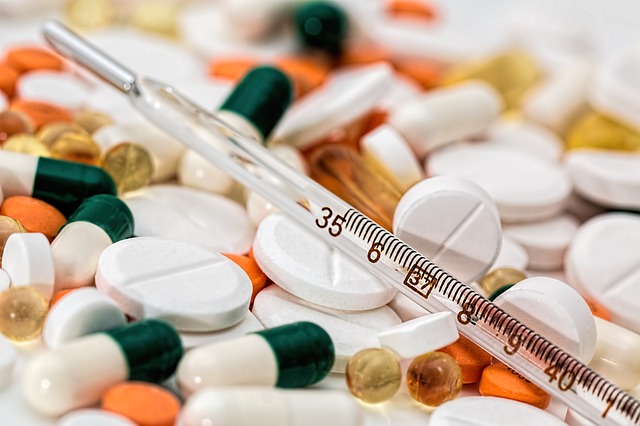
.jpg)
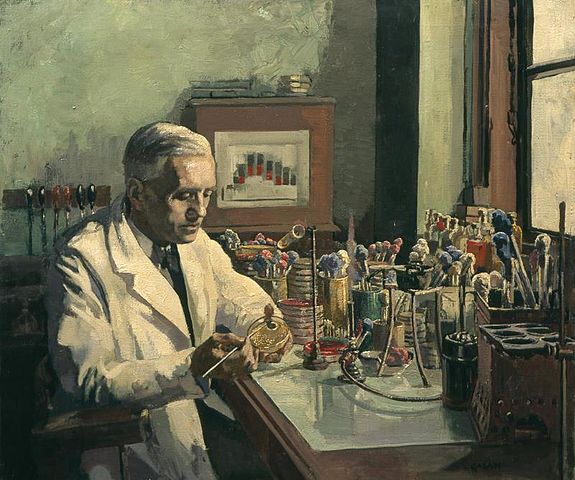
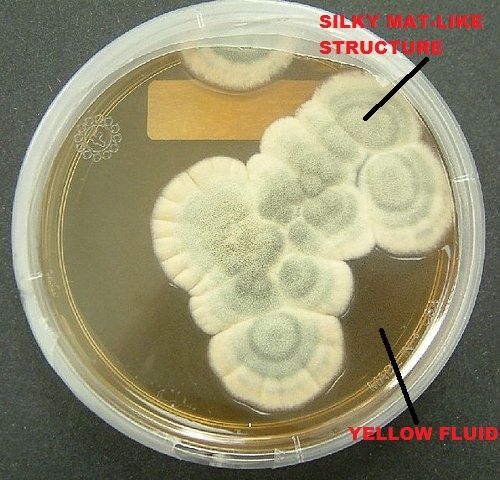
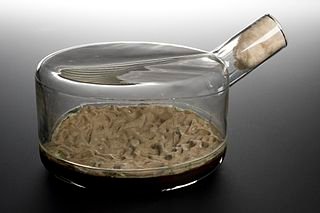
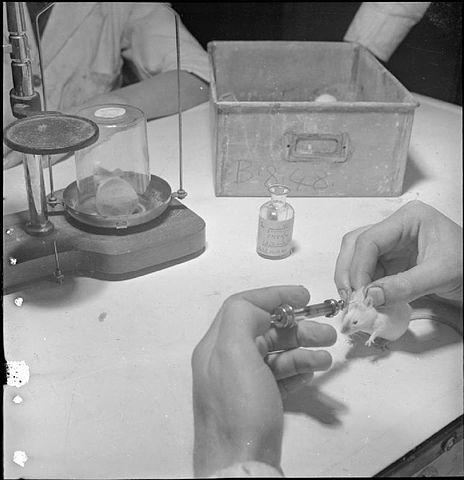
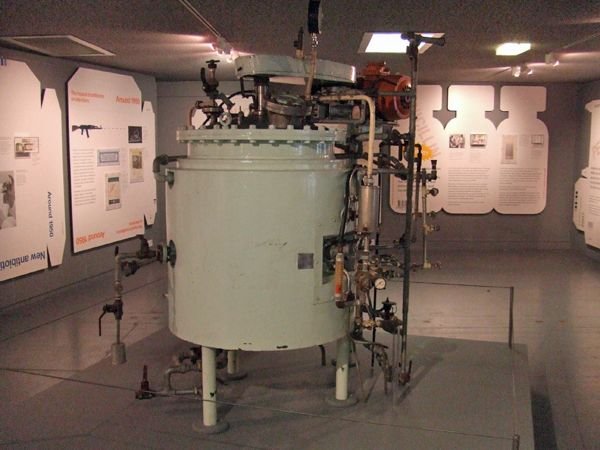
Welcome back @tormiwah. Penicillin and other antibiotics have been a life saver. But the future looks bleak as these bacteria have evolved due to the use of the same antibiotics over time. As they have evolved so must we if we want to stand a chance against them.
Yes we must stand together by reducing our abuse of the use of antibiotics and also embrace other alternatives.
Thanks boss.
And who could have known that such an accidental discovery would save millions of life later on. I hope to discover my own someday as well. Interesting post. I enjoyed it.
Wow, this was a journey.. I enjoyed every bit. I must admit that I never came across any story about it's discovery (might be popular). Neither do I even know Fleming nor the Oxford guys talk less of knowing they got a Nobel Prize (I actually don't know any science history, any, I'm sure. I knw it's bad.. Steemit helping already)
Cooperation is a key phenomenon in any place of human existence. From it, many positives are birthed.
I also disagree that his discovery was by accident even if the circumstances looks so. He had efforts that lead to it and his post efforts are not ignorable...
That's why they say, the kind of friends or people around you have great effect on you. His discovery was helped by the fact that he had relevant people around.
I hope some 'lucky' moment happens and we get lasting cure for HIV and other deadly diseases out there.
This is absolutely fantastic and well researched, no wonder you've been away for long, you were preparing something nice.
Thanks for helping me learn.
That is why @steemstem is here to help.
Yea was not the first to notice the penicillin mould, but his response towards it alone is outstanding compared to others who also saw it.
I do hope we get to see more lucky moments, although some people might be against lucky. Who cares if diseases are treated and averted.
Am glad you love it. Nice welcoming back comment.
You're welcomed.....
Lol, who cares! Let's get cured!
I enjoyed reading your article , unfortunatly today many bacteria develop resistance to penicillin due to the overuse,, we have even noticed the emmergence of super multi_resistant bacteria to all known-antibotics ,, future is dark if we dont wake up soon
This is why we need to embrace personalized medicine, you can be out the lookout for my post about it in coming days. We need to find new systems of making drugs.
Yea, you are right about us embracing personalized medicine. The only challenge to this is organizing the vast information about genes which might also be hard to analysed. But the future is bright for personalized medicine.
Glad you enjoyed reading it
The most interesting about the penicillin story is that fleming also warned the medical field about the resistance problem, guess they turned deaf ears to it.
Yes we all need to wake up, we are the major cause of this problem. Am of the opinion if new antibiotics are produce this will not stop the challenge of resistance as the bacteria will keep evolving.
There is a need for the cooperation that existed during the pre-antibiotic era between nation and the medical field by preventing abuse of the use of antibiotics.
There are certain things which our immune system can fight off naturally without using antibiotics.
And there are several natural alternatives to antibiotics like the phytobiotics, probiotcs and prebiotics.
Thanks
Reading about the discovery of penicillin made me realize Fleming had to work hard to better the initial discovery which came at the right time.
I remember the first time I saw that tube with the ointment in it. I wasted it then not knowing how difficult it was to discover such a live saver.
Well done sir and welcome back.
Now you know the difficult process it took to discover penicillin.
That's what we stand to learn from history.
Thanks, bro
Yeah... Thanks for the mind blowing content.
Glad you're back bro.
Its nice to have you back!
The penicillin story has always been a source of inspiration to some scientists - you never can tell what the outcome of your experiment would be.
But its a pity the issue of resistance is not being attended to.
Awesome post sir!
Luck could be helpful some times
Yes little attention is been paid to the issue of resistance nowadays compared to the pre-antibiotic era where scientists were earnestly look for solution to the disease menace facing the world then
The resistance issue presently is one of the major causes of death now, we need the cooperation of every nation, doctors and drug companies to effectively curb this issue.
Thanks for the nice comment.
Feels good to be back.
You really did an extensive research on it. Keep posting articles like this. You deserve it.
Thanks for the nice comment
This is extensively informative... I'm short of words. Well researched article... Good job sir
Great work, I enjoyed your post
Am glad you did